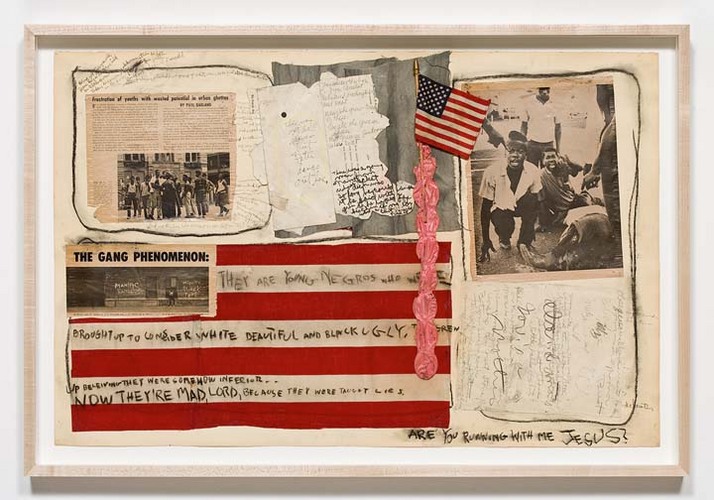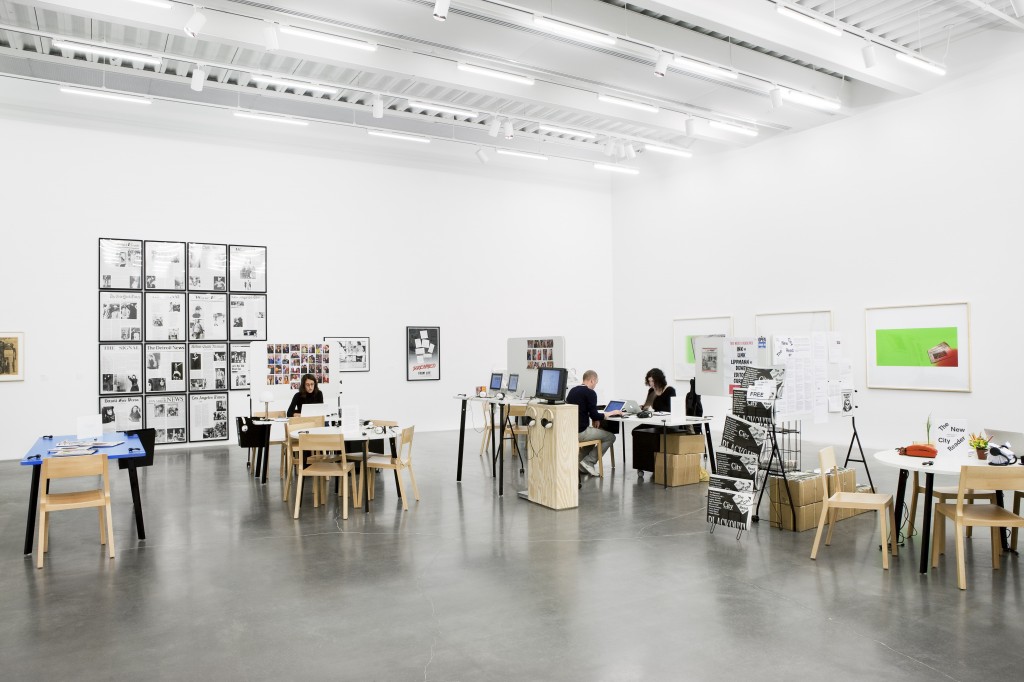
Insider Report: “The Last Newspaper” @ The New Museum
By Benjamin Godsill, co-curator
One of the most exciting elements of “The Last Newspaper” to me as a curator was the ability to work actively and collaboratively with such a wide range of dynamic groups and individuals in order to realize projects for the first time. What really sets this exhibition apart is its mixture of traditional art objects or experiences (painting, works on paper, sculpture, even performance) along with our “partner organizations” – groups that we have invited to set up offices in our galleries. Using prototype modular furniture, designed by BluDot especially for the exhibition, our partners inhabit the gallery spaces and animate them with their active projects; for example the Barcelona-based “curatorial office” Latitudes (Max Andrews & Mariana Canepa Luna) are reporting, writing, editing, and designing a weekly newspaper on site. For audiences we are hoping that having groups working on site will open up the space of the museum and make it seem as much a visible forum for ideas as it is for the display of objects.
The notion of inviting these partners into the space of the museum grows out of the general questions posed by the artists included in “The Last Newspaper”. In work made from 1967 through the present day the artists in the exhibition are dissembling the form and format of the newspaper; often these acts of deconstruction are quite material and literal such as Judith Bernstein’s collages Are You Running with Me Jesus and L.B.J. (both works 1967). In both works Bernstein pulls together news stories from various sources about hot-button topics of the day using the format of collage to put them in physical proximity on the same picture plane and then angrily intercedes and “talks back” to the news with handwritten reactions. Almost like a prescient version of a blog thirty-five years before the fact, Bernstein’s work is an effort to upend the top-down structure inherent in newspapers, news gathered from the few and then distributed to the many. All of the works, by calling into question how news is gathered and distributed, are really putting forth an analysis that asks who has the power to gather information about the world, and what their possibly inherent biases may be. It is from this position of questioning that our interest in working with active resident groups developed.
If the artists included in “The Last Newspaper” evince themselves to being early and vocal critics of modern news organizations and have engaged in various modes of deconstruction of a top-down format of news gathering and distribution, the partner organizations we have included seek to find new, perhaps more holistic ways to gather and represent narratives about contemporary life. In addition to the weekly newspaper published by Latitudes, a team from Columbia University under the leadership of Joseph Grima (executive editor of Domus) and Kazys Varnelis (director of Columbia’s Networked Architecture lab) are publishing another weekly newspaper produced on site: the New City Reader an attempt to document the living and changing city. In addition StoryCorps, an award winning Brooklyn based group of radio documentarians, are on site and exploring different ways of making their thousands of recorded interviews with everyday Americans available to diverse audiences. The Center for Urban Pedagogy has taken residence in order to explore new ways of making the cities we all live in more understandable and responsive to all of their inhabitants. In watching these groups and the other active participants in the exhibition over the two weeks that we have been open to the public, it has become apparent that despite their diversity, they are all engaged in trying to find new ways of making our contemporary world more legible to us all. Each and every one of them really is a new gathering organization in that they are going out, finding facts about the world, gathering data, and then finding simple ways to present these facts in a way that clearly describes the conditions of the present day.
As has always been our intention the exhibition has come alive as an exercise in what can be termed “citizen journalism.” Both the artists and the partners are working to find peer-to-peer modes for describing the world around us, and hopefully in that process finding new, perhaps more holistic ways, to share that information to engender positive ways to remake or re-imagine the public sphere.
“The Last Newspaper” at The New Museum: Through Jan 9, 235 Bowery, New York, 212-219-1222; newmuseum.org.
Recent Content
-
Artsarticle ·
-
Artsarticle ·
-
Artsarticle ·

